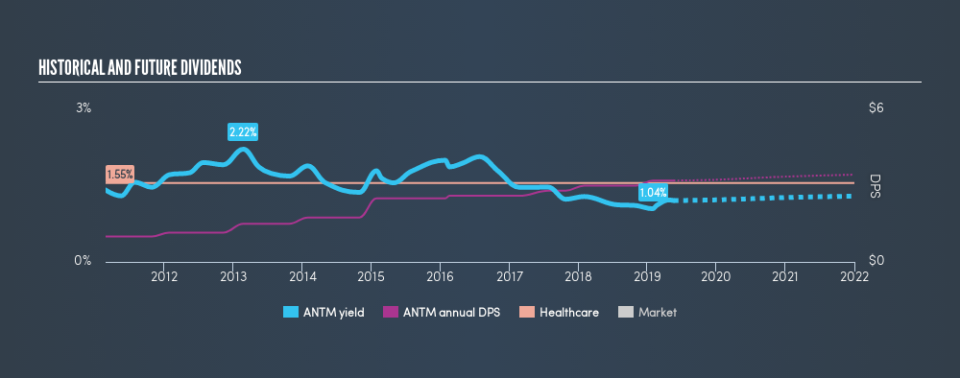You Have To Love Anthem, Inc.'s (NYSE:ANTM) Dividend

Today we'll take a closer look at Anthem, Inc. (NYSE:ANTM) from a dividend investor's perspective. Owning a strong business and reinvesting the dividends is widely seen as an attractive way of growing your wealth. On the other hand, investors have been known to buy a stock because of its yield, and then lose money if the company's dividend doesn't live up to expectations.
With a 1.2% yield and a eight-year payment history, investors probably think Anthem looks like a reliable dividend stock. A low yield is generally a turn-off, but if the prospects for earnings growth were strong, investors might be pleasantly surprised by the long-term results. Some simple analysis can reduce the risk of holding Anthem for its dividend, and we'll focus on the most important aspects below.
Click the interactive chart for our full dividend analysis
Want to participate in a short research study? Help shape the future of investing tools and you could win a $250 gift card!
Payout ratios
Dividends are typically paid from company earnings. If a company pays more in dividends than it earned, then the dividend might become unsustainable - hardly an ideal situation. Comparing dividend payments to a company's net profit after tax is a simple way of reality-checking whether a dividend is sustainable. Looking at the data, we can see that 20% of Anthem's profits were paid out as dividends in the last 12 months. We'd say its dividends are thoroughly covered by earnings.
Another important check we do is to see if the free cash flow generated is sufficient to pay the dividend. Anthem's cash payout ratio in the last year was 38%, which suggests dividends were well covered by cash generated by the business.
Is Anthem's Balance Sheet Risky?
As Anthem has a meaningful amount of debt, we need to check its balance sheet to see if the company might have debt risks. A quick way to check a company's financial situation uses these two ratios: net debt divided by EBITDA (earnings before interest, tax, depreciation and amortisation), and net interest cover. Net debt to EBITDA is a measure of a company's total debt. Net interest cover measures the ability to meet interest payments on debt. Essentially we check that a) a company does not have too much debt, and b) that it can afford to pay the interest. With net debt of more than twice its EBITDA, Anthem has a noticeable amount of debt, although if business stays steady, this may not be overly concerning.
We calculated its interest cover by measuring its earnings before interest and tax (EBIT), and dividing this by the company's net interest expense. Anthem has EBIT of 8.04 times its interest expense, which we think is adequate.
Remember, you can always get a snapshot of Anthem's latest financial position, by checking our visualisation of its financial health.
Dividend Volatility
Before buying a stock for its income, we want to see if the dividends have been stable in the past, and if the company has a track record of maintaining its dividend. Looking at the last decade of data, we can see that Anthem paid its first dividend at least eight years ago. The company has been paying a stable dividend for a while now, which is great. However we'd prefer to see consistency for a few more years before giving it our full seal of approval. During the past eight-year period, the first annual payment was US$1.00 in 2011, compared to US$3.20 last year. Dividends per share have grown at approximately 16% per year over this time.
The dividend has been growing pretty quickly, which could be enough to get us interested even though the dividend history is relatively short. Further research may be warranted.
Dividend Growth Potential
Examining whether the dividend is affordable and stable is important. However, it's also important to assess if earnings per share (EPS) are growing. Growing EPS can help maintain or increase the purchasing power of the dividend over the long run. It's good to see Anthem has been growing its earnings per share at 12% a year over the past 5 years. Earnings per share are growing at a solid clip, and the payout ratio is low. We think this is an ideal combination in a dividend stock.
Conclusion
Dividend investors should always want to know if a) a company's dividends are affordable, b) if there is a track record of consistent payments, and c) if the dividend is capable of growing. Firstly, we like that Anthem has low and conservative payout ratios. We were also glad to see it growing earnings, although its dividend history is not as long as we'd like. All things considered, Anthem looks like a strong prospect. At the right valuation, it could be something special.
Companies that are growing earnings tend to be the best dividend stocks over the long term. See what the 15 analysts we track are forecasting for Anthem for free with public analyst estimates for the company.
We have also put together a list of global stocks with a market capitalisation above $1bn and yielding more 3%.
We aim to bring you long-term focused research analysis driven by fundamental data. Note that our analysis may not factor in the latest price-sensitive company announcements or qualitative material.
If you spot an error that warrants correction, please contact the editor at editorial-team@simplywallst.com. This article by Simply Wall St is general in nature. It does not constitute a recommendation to buy or sell any stock, and does not take account of your objectives, or your financial situation. Simply Wall St has no position in the stocks mentioned. Thank you for reading.

